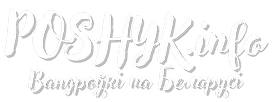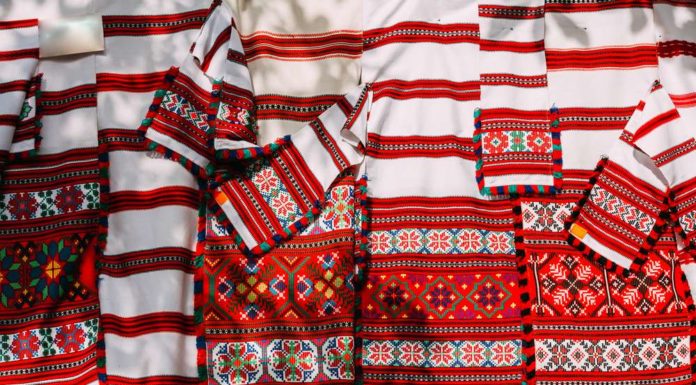Belarusian embroidery: history, symbols, embroidery methods and ornament
Hand embroidery - one of the most common and accessible types of female creativity. Perhaps it is difficult to find such a people whose national costume would not be decorated with ornaments. Having arisen a very long time ago, this art created traditions of embroidered patterns inherent only to them among different nationalities.
In Russia, home embroidery was known and spread everywhere, since this occupation did not require any special devices, only canvas, threads and needles. And this occupation was exclusively female, it was comprehended from 8-9 years old, when peasant girls began to prepare a dowry for themselves. It's no joke, at least 40 towels had to be saved for the wedding. This painstaking work sometimes took several months.

In Russian villages, it was women who kept the rituals that ensured the welfare of the family. Embroidery was usually started after spinning and weaving, when the days were getting long and bright. And decorating the fabric with bright patterns, girls and women sincerely believed in their miraculous power.
Belarusian embroidery and the first mention of embroidery in Belarus
Early patterns of Belarusian embroidery were found on the remains of leather shoes of the 4th-XNUMXth centuries. The most common were the simplest patterns-symbols: rhombuses, divided into XNUMX parts, squares, crosses, triangles, rings, etc. They were also preserved in the embroidery of the XNUMXth-XNUMXth centuries. Pagan mythology was reflected in ancient symbolism - images of the symbols of the sun, the tree of life, fields, birds, water. Linen and woolen threads were used. Ornamental embroidery was placed on sleeves, collars, hems of shirts, apron, and headdresses. Men's neckerchiefs, tablecloths and ceremonial towels were also decorated with ornaments. The embroidery technique improved along with the evolution of clothing (different ways of making and decorating) and the development of spinning and weaving.

Belarusian folk embroidery is characterized by the combination of various methods and techniques into one textured and compositional whole. It has ornamental and technological regional features and differences. So, the embroidery of the Dnieper region, the central Belarus, Eastern and Western Polissya. By the 50s, the traditional counting technique with geometric ornaments was replaced by a free polychrome surface and floral and floral patterns characteristic of it. This type of ornamentation is most often found on towels from Drogichin.
By the beginning of the 20th century embroidery acquired the form of a craft, embroidery workshops appeared, the products of which were exported to other countries. In the 50s in cities such as Slutsk, Bobruisk, Vitebsk embroidery artels worked, which were later transformed into factories of art products.
Threads and embroidery method
Belarusian embroiderers used both natural white cotton yarn and dyed blue and black. Linen and woolen threads were less popular, they were mainly used in line sewing and for ornamenting cloth and woolen fabrics.
Embroidery method "forward igloo" represents the passage of the thread through the fabric from the right hand to the left. The seam looks like a dotted line, in which the length of the stitches and spacing can be varied as needed.

When making a seam "for the needle" the thread is also led from the right hand to the left, but the needle is injected behind the thread at a distance of one stitch, and brought to the surface at a distance of 2 stitches from the place where the thread comes out of the fabric. Thus, a dotted line is obtained from the front side, and a solid line from the inside.

"Stalked" the seam is stitches that are tightly adjacent to each other, each of which protrudes from the previous half.
Embroidery "set". It looked like an ornamental strip - a border formed by a certain number of rows of a seam "forward the needle." The thread was stretched immediately through the entire length or width of the pattern, and each subsequent row turned out to be one horizontal thread lower than the previous one. This method of embroidery was used to decorate towel hats, festive shirts, and aprons.

Cross-stitch" - a countable type of needlework, with many varieties.
A simple "cross" - two diagonally crossed stitches.

"Half Cross" - This is the first stitch when making a simple "cross".

Double "cross" - when they alternated simple "crosses" with small straight lines between them.

Another traditional kind of Belarusian embroidery was called “plyatsyonka". Its appearance resembles a pigtail of short stitches overlapping each other.
A significant place in Belarusian embroidery is also occupied by seams “stitch» straight and obliqueand free.



Traditional colors of the Belarusian national ornament
В Belarus The purity of the patterns was preserved until the XNUMXth century. Our colors are red patterns и White background. White is a symbol of purity, and red is the color of the sun and blood, as a life force. At the end of the XIX century. Belarusian embroiderers began to use black, but not as a predominant color, but to shade red. Blue and yellow colors can also sometimes be found in folk costumes.

The main symbols of Belarusian embroidery
The Belarusian national ornament is not just a decoration of the outfit, in it each pattern has its own meaning and sacred meaning. This is a special cipher of our people, the elements of which symbolize beauty and goodness, give hope and strength, embody the love and respect of a person for his native land and his ancestors.
Basically, a clear geometry can be traced in the Belarusian ornament: the patterns lined up in the form of a geometrically regular cube, or consisted of squares and rhombuses.
patterns of life
The heyday of nature and life was displayed by embroidering sun symbol, which is often combined with earth symbol. Such a pattern was found in every peasant house, since it was considered miraculous.

The beginning of all life мать. Therefore, her image is one of the most popular patterns of life, the attitude towards which our ancestors had was very reverent.

Childless families were embroidered Mothers in Childbirth. And to protect children from the evil eye and misfortune, they also used a special amulet sign.

Holiday patterns
The life of any village could not do without holidays, which were also reflected in embroidery. For example, bathing, carnival or wedding.

Patterns of fertility and harvest
В pagan times the Sun and the Earth were held in high esteem, because thanks to their union, the harvest grows every year. A symbol of the awakening of nature and the sun - Jarilowho is often depicted on horseback. Another important symbol was Zhitnaya Baba.

Lyrical and poetic moods in folk art were expressed through the image Birds. The cuckoo, for example, symbolized a widowed woman, the nightingale - a poet who sang love, the falcon acted as the image of a loved one, and the eagle personified a hero. The dove became the symbol of love and peace. A pair of doves with their heads turned to one side is a young couple. If the birds look at each other, and between them there is also a flower bouquet depicted, this speaks of love in its prime. Well, when both doves turned away in different directions, everything, love, unfortunately, ended.

Images of pagan mythology
Belarusians, like most peoples, previously had a cult of the sacred tree of life. Sacred oaks were located in the center of the temples, and these trees could not be cut, otherwise you would bring misfortune on yourself and your family. The tree of life personified eternal life, so this pattern was one of the main images used by craftswomen in their embroidery.

Bereginya - patronized the family hearth, needlework and housekeeping.

Other symbols were also used in the patterns, which complemented the overall picture of embroidery. For example, symbols of the gods, our ancestors, man, bread or women's share.

It is noteworthy that the Belarusians did not use patterns that would symbolize death or grief.
Ornament as a kind of folk magic
Our ancestors believed that with the help of an ornament one could protect oneself from evil, turn to the gods for blessings, but non-locals, thanks to embroidered patterns, could get an idea of the worldview of people that dominated in a particular area.
The body shirt was always sewn with magical precaution, since it not only warmed, but also drove away evil forces, and kept the soul in the body. When cutting the collar, the cut out flap had to be dragged inside the future clothes, such a movement - inside - was done to preserve and accumulate vitality.

The ornament was necessarily embroidered in such places as the collar, sleeves, hem, on headdresses - in the frame of the face. It was believed that evil could gain access to the body through open spaces. A protective embroidery will help protect them. Ancient Belarusians also believed that amulets on clothes help no worse than the healers of that time. Therefore, when someone was sick, the craftswoman embroidered certain signs on his shirt that contributed to a speedy recovery.
There was also a tradition of ritual towels among the people. When some kind of misfortune happened - crop failure or drought, for example - then the women gathered together at someone's house and wove a towel, and then embroidered a certain pattern on it. After the product was taken to the grave of the ancestor, so that he would take trouble away from the village.
The semantic meaning of such patterns, as well as the rite of reading them, was passed on by craftswomen from the older generation to the younger one until the beginning of the XNUMXth century. And then the sacred meaning of folk embroidery began to be gradually forgotten, and the embroiderers remembered only that they contained the forces of good.
We also recommend our materials "Understanding the characters of our mythology"And"10 gift options from a trip to Belarus!"
text: Ekaterina Golubnicchaya
















